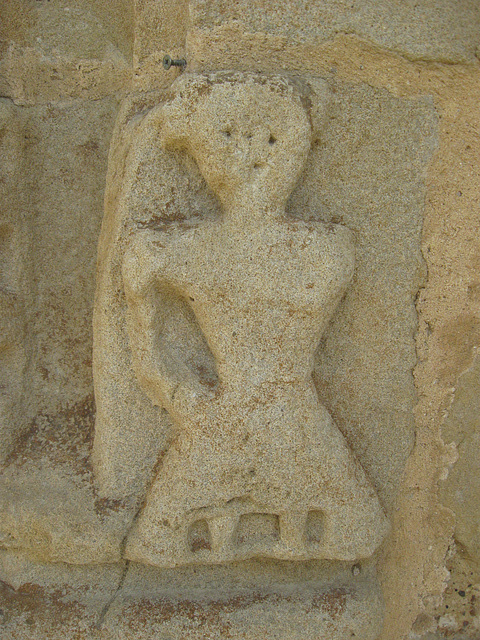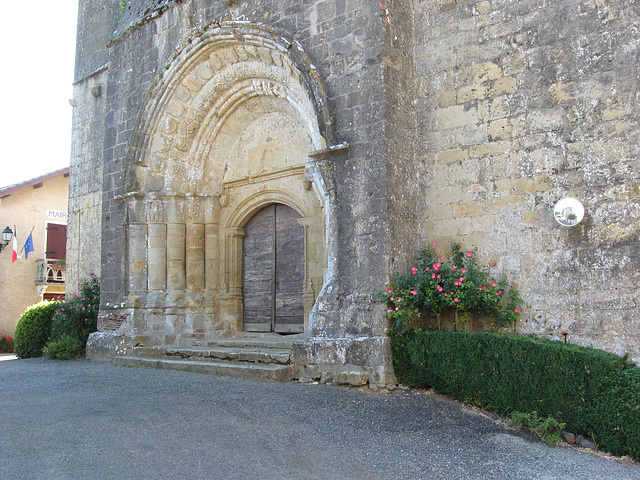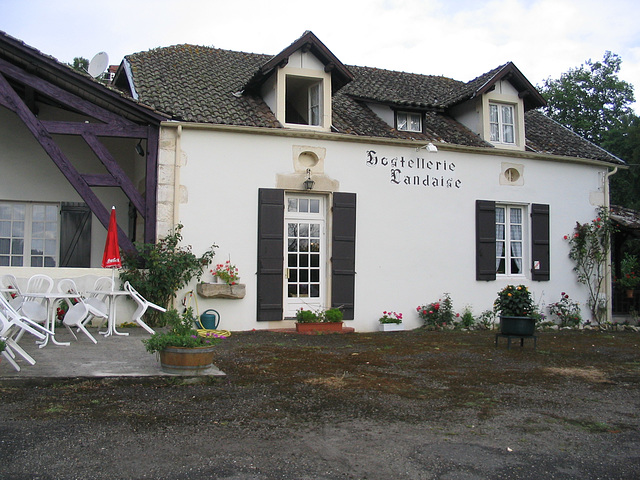
Nouvelle-Aquitaine
The region was created by the territorial reform of French regions in 2014 through the merger of three regions: Aquitaine, Limousin and Poitou-Charentes.
It contains 12 deps.: Charente, Charente-Maritime, Corrèze, Creuse, Deux-Sèvres, Dordogne, Gironde, Haute-Vienne, Landes,Lot-et-Garonne, Pyrénées-Atlantiques and Vienne
It contains 12 deps.: Charente, Charente-Maritime, Corrèze, Creuse, Deux-Sèvres, Dordogne, Gironde, Haute-Vienne, Landes,Lot-et-Garonne, Pyrénées-Atlantiques and Vienne
Saint-Justin - Chambre d'arrêt
Saint-Justin was founded in 1280 as a bastide, a fortified town,
The town still has three octagonal towers and a walkway along the ramparts and the tower wall. And this "chambre d'arrêt".
A weathered pilgrim in Pimbo
..... since more than 800 years, he has his eyes on everything around. This year he was
an eyewitness of the little birthday party we had prepared next to the church in Pimbo....
The church in Pimbo - and me in the mirror.
...on the right hand side, next to the entrance door of "Saint-Barthélémy", there is the old eyewitness (see the other Pimbo-foto). To see me you have to focus on the mirror on the right hand side...
Roquefort
..must have been a very modern building. Back in the 1920s/1930s. Influenced by German Bauhaus or early Russian Modernism. Now it does need a lot of care.
Retjons
The food was very good - and the rooms will be ok, after the renovation.
Saint-Gein - Saint-Pierre
The village of Saint-Gein (pop below 500) has this massive church, dedicated to St. Peter. It has an interesting narthex, similar to many churches around Troyes in the departemant Aube. At 5pm the afternoon the church was locked already, so I could notr find out any details.
Hastingues - Abbaye d'Arthous
The abbey "Sainte-Marie d'Arthous" was founded around 1160. This was filiation of the Premonstratensian "Abbaye de la Case-Dieu" in Gers (120 kms east). The building of the church, seen here, was started soon after. It got already consecrated in 1167.
The neighbouring bastide Hastingues was founded in 1289 by John Hastings, seneschal of Gascony. This was done following a treaty between Edward I of England, Duke of Aquitaine and the monks of the Abbaye d'Arthous.
During the War of Religions the abbey got ruined and lost the importance it once had. Though restored, only 5 monks lived here in 1766, so after the Revolution the abbey was sold by the state - and used as a farm.
The church is known for some extraordinary corbels around the apses.
The abbey was founded to support the pilgrims on their way to Santiago de Compostela. Still today the "pelerins" find a place to here
www.arthous.landes.org/index.php?id=715
Hastingues - Abbaye d'Arthous
The abbey "Sainte-Marie d'Arthous" was founded around 1160. This was filiation of the Premonstratensian "Abbaye de la Case-Dieu" in Gers (120 kms east). The building of the church, seen here, was started soon after. It got already consecrated in 1167.
The neighbouring bastide Hastingues was founded in 1289 by John Hastings, seneschal of Gascony. This was done following a treaty between Edward I of England, Duke of Aquitaine and the monks of the Abbaye d'Arthous.
During the War of Religions the abbey got ruined and lost the importance it once had. Though restored, only 5 monks lived here in 1766, so after the Revolution the abbey was sold by the state - and used as a farm.
The abbey church is known for some extraordinary corbels around the apses. Here are three of them:
A grimacing head ("mouth puller"), a musician (playing the dolio) and a kind of lion (?) with a curly fur and a very small head. Note the small human head between the leaves to the right. A strange kind of bud.
Hastingues - Abbaye d'Arthous
The abbey "Sainte-Marie d'Arthous" was founded around 1160. This was filiation of the Premonstratensian "Abbaye de la Case-Dieu" in Gers (120 kms east). The building of the church, seen here, was started soon after. It got already consecrated in 1167.
The neighbouring bastide Hastingues was founded in 1289 by John Hastings, seneschal of Gascony. This was done following a treaty between Edward I of England, Duke of Aquitaine and the monks of the Abbaye d'Arthous.
During the War of Religions the abbey got ruined and lost the importance it once had. Though restored, only 5 monks lived here in 1766, so after the Revolution the abbey was sold by the state - and used as a farm.
The abbey church is known for some extraordinary corbels around the apses.
Here are three twosomes.
Two naked Luxurae, holding snakes, two clerics with cross and a holy water dispenser (looks like a shaving brush), two bald men (straight from a Flying Saucer in Roswell). One holds a sword (= war?) and the other a branch (= peace?). What is that small ball near the elbow of the left guy.
Jump to top
RSS feed- Latest items - Subscribe to the latest items added to this album
- ipernity © 2007-2025
- Help & Contact
|
Club news
|
About ipernity
|
History |
ipernity Club & Prices |
Guide of good conduct
Donate | Group guidelines | Privacy policy | Terms of use | Statutes | In memoria -
Facebook
Twitter










